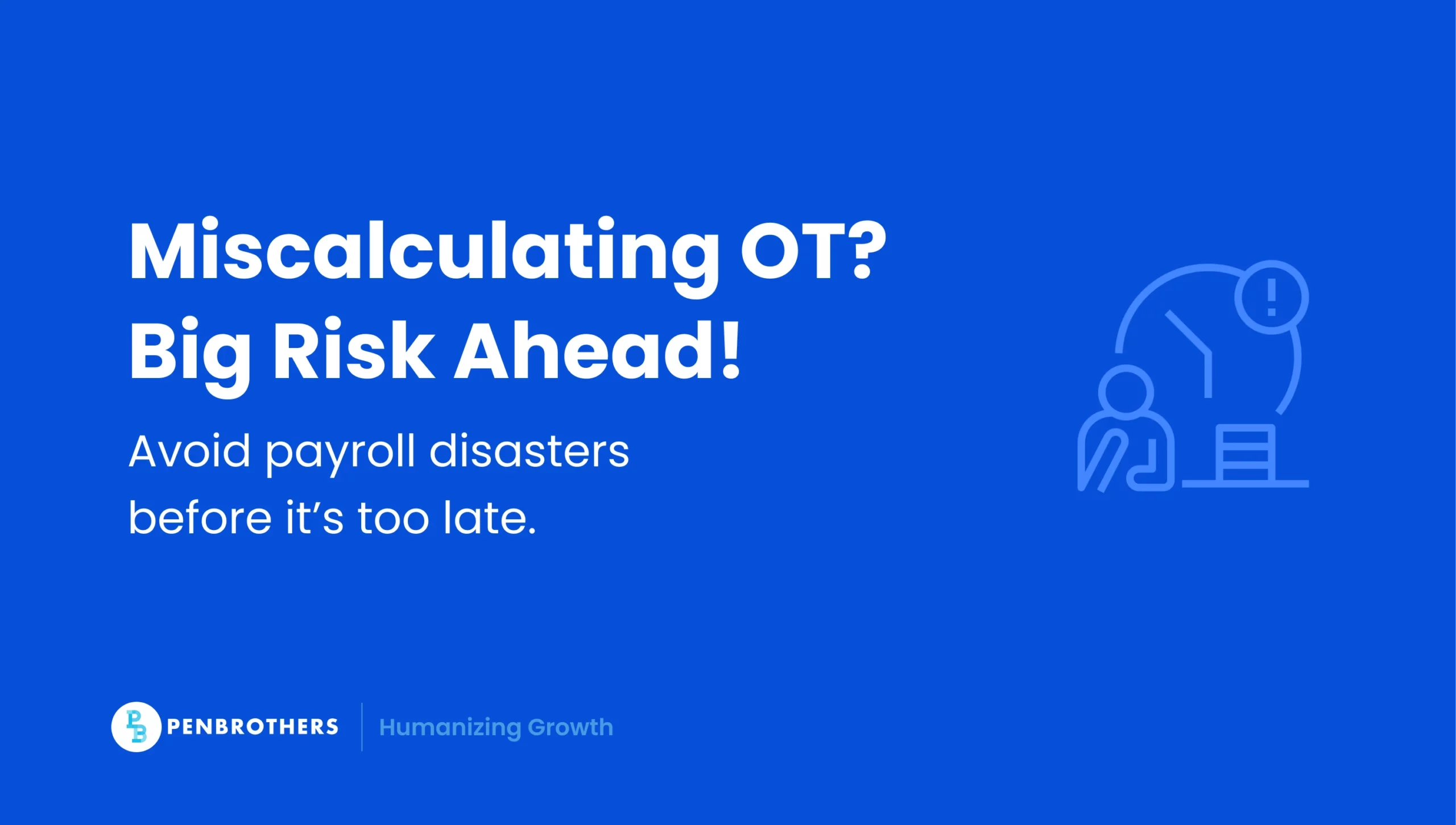What's Inside?
How to Compute Overtime Pay in the Philippines: 2025 Guide

Overtime pay ensures that employees are fairly compensated for work beyond their regular hours. Under the Philippine Labor Code, employers must pay overtime based on specific rates, depending on the type of day (regular workday, holiday, or rest day).
In this guide, we’ll break down the step-by-step computation of OT pay, explain legal policies employers must follow, and highlight common payroll mistakes to avoid. We’ll also explore how payroll software can automate overtime calculations and what employees can do if their OT pay isn’t paid correctly.
Key Takeaways
- It Starts with the Hourly Rate: Before any overtime calculation, you must first determine the employee’s hourly rate.
- The Rate Depends Entirely on the Day: The overtime multiplier changes significantly based on when the work is performed. The key rates are 125% for a regular workday, 169% for a rest day or special non-working holiday, and 260% for a regular holiday.
- Don’t Forget the Night Shift Differential: Any work performed between 10:00 PM and 6:00 AM requires an additional 10% premium. This night differential is applied on top of the regular hourly rate or the applicable overtime rate, making it a common source of payroll errors if missed.
- Know Who Is Entitled: Overtime pay is mandatory for all rank-and-file employees. Managers, field personnel, and those paid on an output basis are generally exempt. Employers must keep accurate records and pay correctly to avoid penalties from the Department of Labor and Employment (DOLE).
Step-by-Step Guide: How to Compute OT Pay
Calculating OT pay requires applying the correct rate based on an employee’s salary and work schedule. Follow these steps:
Step 1: Identify the Employee’s Hourly Rate
- Formula:
Hourly Rate = Monthly Salary × 12 Months / Number of Working Days per Year × Number of Hours per Day - Example:
- Monthly Salary: ₱20,000
- Working Days per Year: 261 (standard for private companies)
- Hourly Rate = (20,000 × 12) ÷ (261 × 8) = ₱114.94
Step 2: Apply the Correct Overtime Multiplier
Overtime rates depend on when the overtime work was performed:
| Type of Overtime | Overtime Rate Multiplier |
| Regular Workday | 125% (1.25) |
| Rest Day or Special Holiday Overtime | 169% (1.69) |
| Regular Holiday Overtime | 260% (2.60) |
| Night Shift Overtime | 110% (1.10) additional to standard OT rate |
Related: It’s essential to see salary ranges as they impact OT pay.
Step 3: Multiply by Overtime Hours Worked
Overtime Pay = Hourly Rate × Overtime Rate × Overtime Hours Worked
How to Calculate 1 Hour of Overtime
One hour of overtime is calculated by multiplying your hourly rate by the applicable overtime rate. On a regular workday, this is 1.25 times your standard rate. However, payroll errors often occur when context is ignored. Was the hour worked after 10 PM? Was it during a rest day or a special holiday? That one hour might actually qualify for 1.69 times, 2.6 times, or a combination that includes night differential. This matters most in shift-based operations, where schedules rarely fit within the usual nine-to-five, and accurate timekeeping determines whether staff are paid fairly or not at all.
If your team regularly logs an extra hour per shift, it is worth examining the root cause. Is the overtime due to delays, poor handoffs, or system inefficiencies that require employees to stay past their schedule? While accurate pay is critical, so is understanding why overtime happens in the first place. Whether it stems from tool limitations, unrealistic deadlines, or last-minute client demands, identifying the cause helps refine scheduling and avoid quietly exhausting your top performers.
Step 4: Add Night Shift Differential (if applicable)
Employees working between 10 PM and 6 AM receive an additional 10% premium. If overtime is performed during this period, both overtime pay and night shift differential apply.
Step 5: Deduct Any Required Taxes & Contributions
- Overtime pay is taxable as part of an employee’s gross salary.
- SSS, PhilHealth, and Pag-IBIG contributions may also be deducted if overtime pay increases the employee’s total earnings for the period.
Now that we understand how to compute overtime pay, let’s dive into the legal rules employers must follow.
Related: Know the full list of employee benefits.
Philippine Labor Code: Overtime Pay Rules Explained
The Department of Labor and Employment (DOLE) enforces strict guidelines for overtime pay. Employers must comply with the following:
Maximum Legal Overtime Hours
Employees can work a maximum of 8 hours per day, with overtime subject to employee consent (except in emergencies).
Who Qualifies for Overtime Pay?
- Entitled: Rank-and-file employees (regardless of employment status).
- Exempted: Managers, field personnel, government employees, and workers on output-based compensation.
Employer Obligations & Penalties
- Failure to pay overtime can lead to DOLE investigations, back payments, and penalties.
- Employers must keep accurate payroll records and ensure timely compensation.
For full labor law details, refer to DOLE’s official overtime pay guidelines.
Now, let’s explore real-world overtime pay computation scenarios.
Related: Payroll in the Philippines: Your Complete Guide
Is 30 Minutes Considered OT?
Yes. Thirty minutes of extra work counts as overtime if it goes beyond the standard eight-hour workday. However, this is often ignored because it seems too minor to matter. When left untracked, these small extensions quietly add up. For instance, if someone consistently stays an extra 30 minutes to finish reports or assist with handovers, that adds up to more than 10 hours of unpaid labor each month. When that effort goes unrecognized, it can create friction that appears not only in disputes but also in disengagement. Unfortunately, many policies lack clear language around overtime thresholds under one hour, making it easy to overlook these short work extensions.
To prevent issues, timekeeping should be precise, and policies must be transparent. If team culture expects extra effort beyond scheduled hours, it should be reflected in compensation or through adjusted schedules. Some companies account for these 15 to 30-minute extensions with buffer shifts or automatic tracking, especially in client-facing or operations-heavy roles. Employees should keep an eye on recurring short overtime patterns and clarify expectations early, particularly when the work is informal but consistent. Goodwill fades quickly when effort is not acknowledged.
Over Time Pay Computation Scenarios
Here’s how OT pay varies depending on the type of day worked:
| Scenario | Formula | Example Calculation (₱114.94/hour) |
| Regular Workday Overtime (125%) | Hourly Rate × 1.25 × Overtime Hours | (114.94 × 1.25 × 2) = ₱287.35 |
| Rest Day Overtime (169%) | Hourly Rate × 1.69 × Overtime Hours | (114.94 × 1.69 × 2) = ₱388.50 |
| Regular Holiday Overtime (260%) | Hourly Rate × 2.60 × Overtime Hours | (114.94 × 2.60 × 2) = ₱597.68 |
| Night Shift Overtime (110% + OT Rate) | Hourly Rate × 1.10 × Overtime Rate × Overtime Hours | (114.94 × 1.10 × 1.25 × 2) = ₱316.08 |
Errors in computation can lead to payroll disputes. Next, we’ll cover common mistakes and how to avoid them.
How to Calculate 8 Hours of Overtime
Calculating eight hours of overtime is not as simple as multiplying the hourly rate by eight. The total depends heavily on when the overtime was worked. If it falls on a rest day, a holiday, or during night hours (10 PM to 6 AM), different pay multipliers apply. For example, eight hours of overtime on a regular workday is paid at 1.25 times the hourly rate, while the same on a regular holiday can increase to 2.6 times. If those hours overlap with the night shift window, an additional 10 percent is added. In just one shift, multiple pay rates may apply. Many manual payroll systems overlook these layered conditions, leading to underpayments that often escalate into trust issues or retroactive claims.
When eight-hour overtime becomes routine, it can point to larger operational issues such as unrealistic workloads, chronic understaffing, or overdependence on specific roles. Payroll accuracy is just one part of the equation. Managers also need to evaluate whether extended shifts are being used to mask inefficiencies. If employees regularly work 16-hour days, no pay multiplier can compensate for the long-term impact on morale or retention. It is important to track the patterns, not just the rates.
Common Overtime Pay Calculation Mistakes & How to Avoid Them
- Misapplying Overtime Rates: Ensure correct multipliers based on work schedule.
- Forgetting Night Shift Differentials: Night shift workers get an extra 10% premium.
- Late or Missing Overtime Payments: Employers must pay overtime in the next payroll cycle.
- Incorrect Deductions: Double-check tax and benefit deductions on payslips.
Payroll Automation: How Payroll Software Simplifies Overtime Computation
Using payroll software ensures:
- Automated overtime calculations based on Philippine labor laws.
- Accurate payroll records for compliance with DOLE audits.
- Timely overtime payouts to employees.
If you suspect an error in your overtime pay, here’s what you can do.
Employee Rights: What to Do If OT Pay Is Incorrect
- Check Your Payslip: Verify hourly rate, overtime hours, and deductions.
- Raise the Issue with HR – Request a detailed breakdown of your pay.
- Report to DOLE – If unpaid overtime is unresolved, file a complaint with DOLE.
- Seek Legal Advice – If violations persist, consult a labor lawyer.
To help clear up confusion, let’s address some FAQs.
Frequently Asked Questions
Multiply the hourly rate by the applicable overtime multiplier based on work type (e.g., 125% for a regular workday).
Night shift workers receive 10% extra on top of their overtime rate.
No, unless the employee falls under exempted categories (e.g., managerial positions).
Employers must secure DOLE approval for excessive overtime work.
Conclusion
For employers, ensuring accurate overtime pay computations is critical for compliance. Consider using payroll automation or consulting HR professionals to stay compliant with labor laws.
For employees, knowing your overtime pay rights helps ensure you get fair compensation. If you encounter issues, don’t hesitate to seek guidance from HR experts or DOLE representatives. Better yet, perhaps it’s time to seek fair career opportunities with attractive packages.
By understanding overtime pay calculations, both employers and employees can maintain a fair and legally compliant workplace.
*This article was crafted with the support of AI technology and refined by a human editor.





